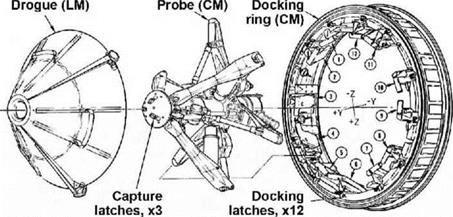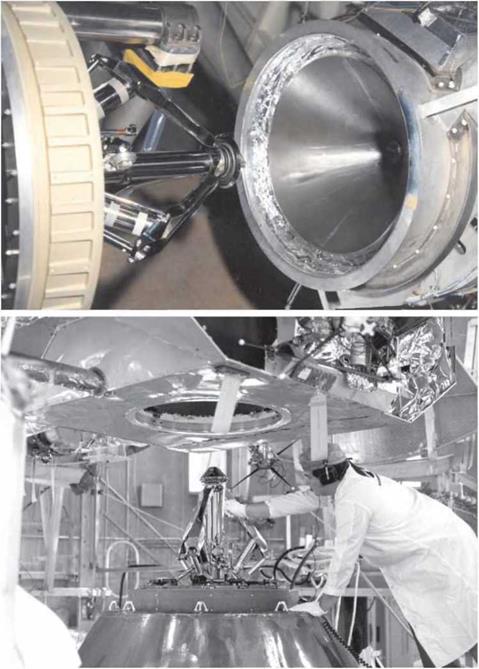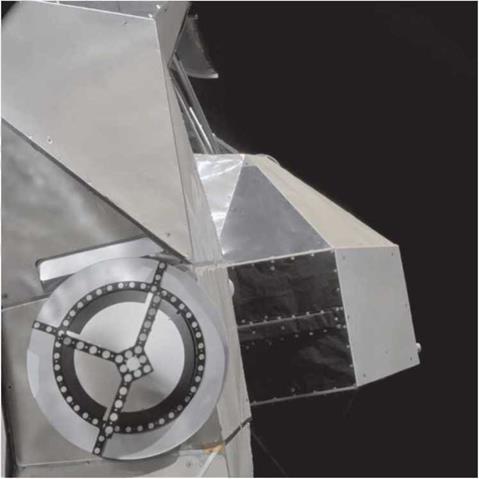Probe and drogue: spacecraft sex
The docking system was one of the many engineering wonders of the Apollo programme and one whose importance is perhaps underplayed. It was an ingenious, compact, pneumatic and mechanical arrangement that managed to elegantly fulfil a number of tasks: it self-centred the two spacecraft as they contacted; it absorbed the shock of that contact to achieve a soft-dock; and, finally, it pulled the two craft together to achieve hard dock and straightened their axes as it did so. It was then collapsible and removable from either the LM or CM side and could be stowed when not required. Years later, Apollo 15 commander David Scott, who was also the first CMP to use the Apollo docking system on Apollo 9, wrote about how crucial it was. "It is really quite important to the whole scheme of the Apollo concept – a very complex apparatus and one of the few single-point failures in the entire system. But at the end of the day, it was probably one of the more brilliant mechanical devices of the programme.”
Like so many plug/socket combinations in the electrical and electronics world, it was a sexed affair with the CSM carrying the male docking probe and the LM providing the receptacle into which the probe was inserted. The movie Apollo 13 played up the suggestive nature of this arrangement when the character of Jack Swigert, who would be the CMP on the Apollo 13 mission and was a bachelor with a reputation as a ladies’ man, was shown using a glass and bottle to demonstrate the Apollo docking system to a beautiful young woman. But the male/female nature of the system limited its future, and later spacecraft instead used androgynous designs which would allow any pair of suitably equipped vehicles to dock. However, despite
|
Diagram showing the elements of the probe and drogue docking mechanism. (NASA) |
|
|
Top. An engineering model of the probe and drogue docking mechanism. Bottom. A test of the docking mechanism for Apollo 14 where Ant ares was turned upside down to perform a docking with Kitty Hawk. (NASA)
|
The docking target on Apollo 12’s lunar module guided Richard Gordon to an accurate docking. (NASA) |
this inherent inflexibility, the probe and drogue arrangement was well suited to the needs of Apollo.
On the CM side, the probe consisted of an articulated tip mounted on the end of a retractable rod. Around this rod were three arms with shock absorbers in their elbow joints. The whole probe assembly could be mounted within the docking ring which itself was bolted to the apex of the command module. This ring carried 12 automatic latches around its circumference that engaged with the LM’s docking ring when the two were brought together by the retraction of the probe.
The LM’s side of the affair was much simpler. The drogue was really just a concave cone with a carefully sized hole in its centre. The purpose of the cone was to gently shepherd the tip of the probe into the hole. Three small spring-loaded capture latches built into the probe’s tip then caught the edge of the hole. This was the ‘soft –
dock’ condition. When commanded, one of four small bottles of nitrogen gas inside the probe energised the retraction mechanism to pull the spacecraft together and as it did so. three pitch arms ensured that both spacecraft were aligned by their contact with the drogue’s conical surface.
When the CSM was manoeuvred towards the LM, use of the docking target and the COAS helped to ensure both spacecraft tvere aligned in pitch, yaw and roll. Remaining pitch and yaw errors were removed by the shock absorbers in the pitch arms as the retraction took place. The roll error was usually small because the COAS and docking target were displaced well away from the centre-line of the docking system. At a later stage of the mission, the LM’s guidance system would be given an approximate alignment by the crew manually reading the appropriate numbers from the command module’s guidance system and passing them across to the LM. These alignments would have to be adjusted to account for the difference in the orientation of the coordinate systems of the two spacecraft. This calculation also meant taking into account any angular misalignment between the two vehicles at docking. To facilitate this, the docking tunnel included markings that allowed the docking index angle to be read off.













